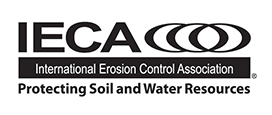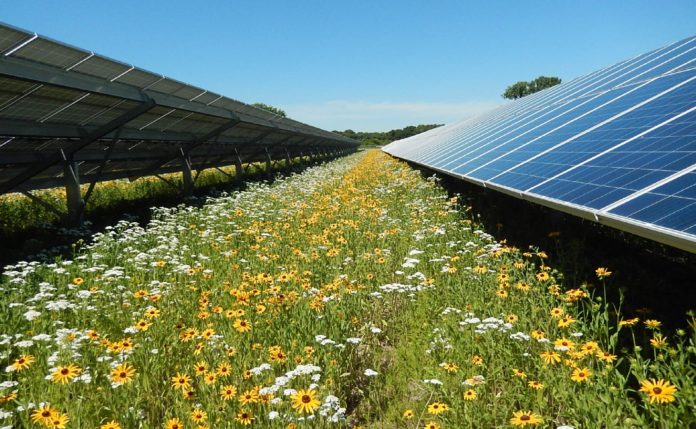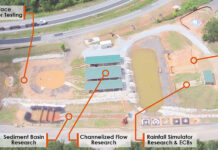Climate change poses an existential threat to ecosystems and the human, animal, insect and plant life living in them as a result of increasing temperatures and changes in precipitation patterns. As a result, there is a significant shift away from non-renewable to renewable energy. At the start of 2022, over 670 gigawatts (GW) of large-scale ground-mounted solar photovoltaic (PV) projects across the U.S. were in the “interconnection queue” — 10 times the total amount of existing large-scale solar (62 GW). If developed, this would be approximately 1.5 million hectares of land, most of it in rural watersheds.
To meet this market demand and see this level of solar development, regulators and developers need to have the same expectations, grounded in scientific understanding, of stormwater and water quality risks. Different jurisdictions, particularly at the local level, treat ground-mounted PV development very differently, not infrequently being treated as impervious surfaces similar to a roof or parking lot. Permitting practices frequently ignore the disconnected pervious soils beneath and between solar arrays. This leads to an overestimation of runoff and an increase in costs related to installing structural practices to mitigate runoff.
The PV-SMaRT Project
Developers and local or state permitting authorities currently do not have models and tools to properly estimate stormwater runoff from ground-mounted solar PV sites with disconnected pervious soils. To address this gap in knowledge, the Department of Energy (DOE) provided funding to the National Renewable Energy Lab (NREL), the University of Minnesota (UofM) and the Great Plains Institute (GPI) to develop a runoff calculator and recommend best practices for estimating and mitigating stormwater runoff at ground-mounted solar PV sites. The objectives of the Photovoltaic Stormwater Management Research and Testing (PV-SMaRT) project include:
- Developing and disseminating a research-based tool for estimating stormwater runoff.
- Identifying best practices for stormwater management at ground-mounted PV facilities.
PV-SMaRT Runoff Calculator
The project team developed an easy-to-use calculator to estimate stormwater runoff from ground-mounted solar PV facilities. This calculator was based on research and hydrologic modeling conducted at five solar PV sites located in Colorado, Georgia, Minnesota, New York and Oregon (Figure 1). Sites represent diverse climatic, topographic and soil conditions, with either fixed or tracking solar arrays, and vegetation that included pollinators, grass or cover crops. Ground truth climatic and hydrologic measurements at each site were used to develop a two-dimensional numerical model for stormwater runoff based on specific combinations of a wide range in 24-hr design storms, soil textures, crop rooting depth, soil bulk densities, presence or absence of solar arrays, spacing of solar arrays, type of ground cover and slope steepness values. The numerical model was capable of accounting for the complex three-dimensional nature of precipitation, drip edge redistribution of rainfall, infiltration, runoff and evapotranspiration in the disconnected pervious areas below and between solar arrays (Figure 2).
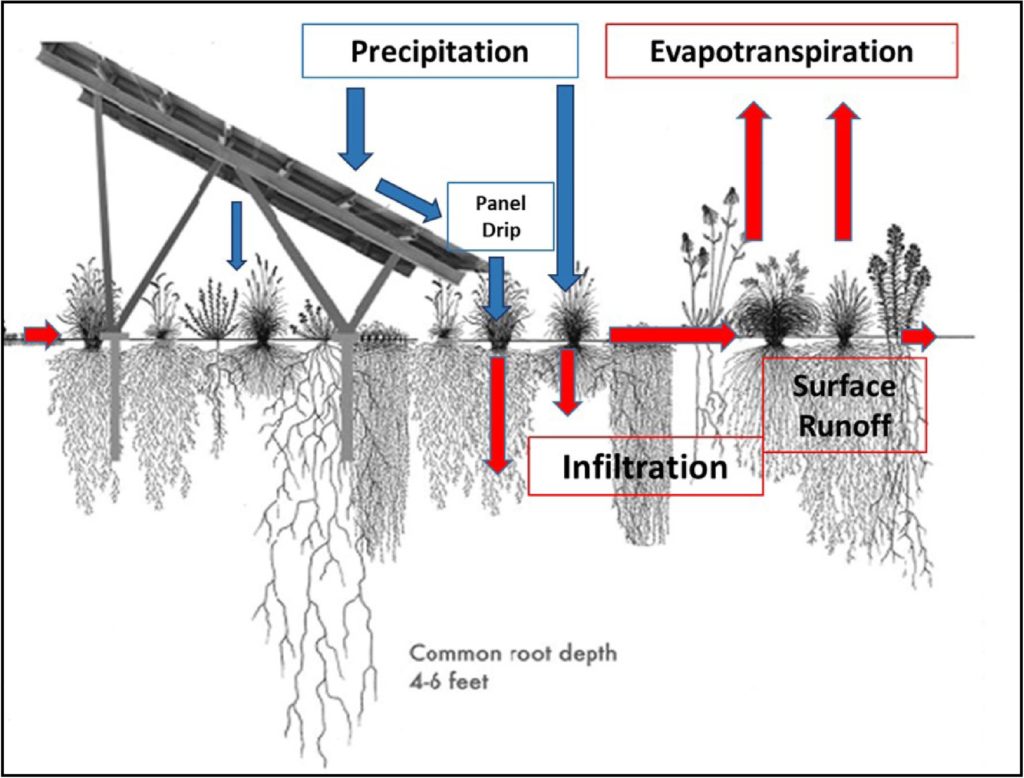
Building Best Practices
The project team also evaluated existing practices used by permitting officials and regulators to measure stormwater and water quality risks, assessed barriers to improving solar and water quality outcomes, and recommended best practices for regulators and solar projects that reflect PV-SMaRT research and modeling findings (Figure 3).
There are recognized cost tradeoffs of increasing panel heights to accommodate the establishment of pollinator plantings. Anecdotally, there can be a 1%–2% increase in overall project costs to accommodate higher panels, but this can be mitigated by cheaper seed mix options and reduced vegetative operation and maintenance costs over the life of the project. Denser vegetation can lead to increased infiltration of water on-site that can reduce stormwater runoff mitigation costs while offsetting the cost of raising the panels and establishing the vegetation, but this has not been quantified. There are commercially viable projects with varied panel height ranges and vegetated cover, so evaluation of these tradeoffs needs to be studied in further depth.
Barriers in existing practices included: use of non-solar-specific standards and curve numbers, disincentives in final stabilization requirements to establishment of ground covers that maximize long-term water quality benefits, and lack of consideration of watershed and green infrastructure benefits of solar development in agricultural watersheds for impaired waters.
The PV-SMaRT research and modeling show that four factors need to be considered in stormwater management and water quality permitting (in order of greatest impact):
- Limit or mitigate compaction of soils during construction and in post-construction maintenance.
- Incorporate crop rooting depth and the site’s infiltration capacity into site design.
- Emphasize deep-rooted, self-sustaining ground covers that reduce bulk density, limit need for long-term mowing and provide the community ecosystem co-benefits.
- Ensure sufficient separation of arrays to sufficiently disconnect array commensurate with site conditions.
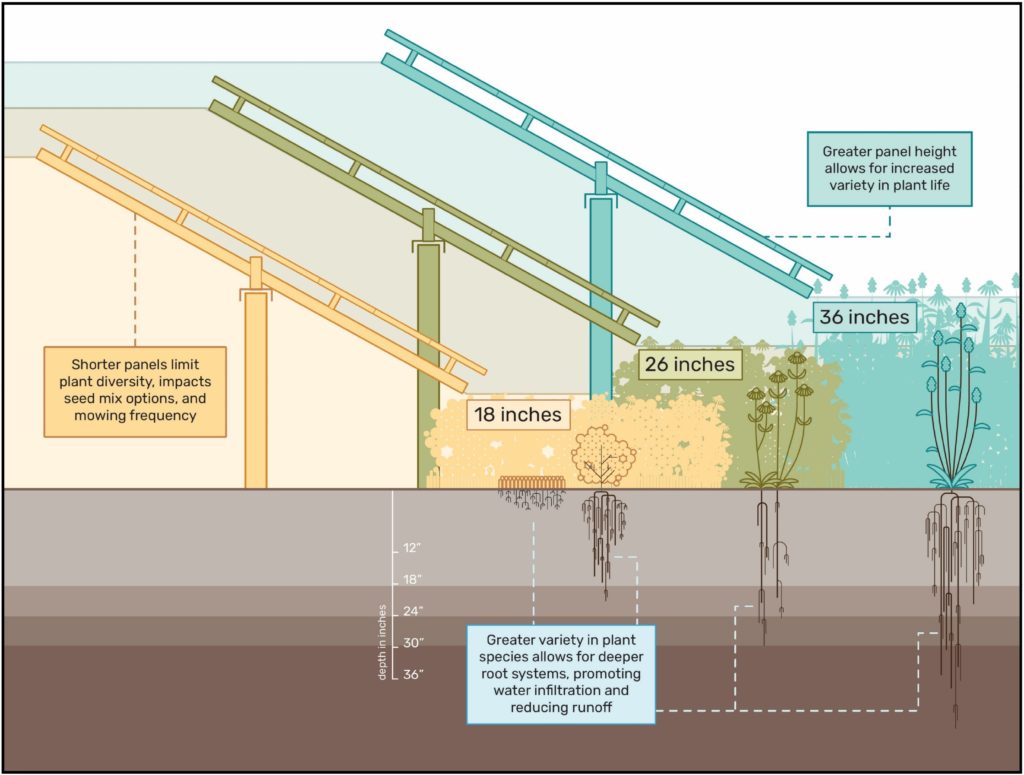
Summary
The PV-SMaRT calculator can be used to evaluate impacts of site-specific characteristics (crop rooting depth, soil bulk density, slope, vegetative cover for a range of array spacings) on runoff curve numbers at ground-mounted solar photovoltaic facilities. Resultant curve numbers can then be used to calculate expected stormwater runoff from a single 24-hour design storm specified by the user. The calculator can be used to estimate runoff based on pre-construction characteristics (without arrays, with pre-construction vegetation), as well as runoff based on post-construction characteristics (soil compaction, different types of vegetation, etc.).
The PV-SMaRT calculator provides more accurate estimates of runoff curve numbers at ground-mounted solar PV sites than using the NRCS Runoff Curve Number (RCN) lookup tables. In general, the NRCS RCN method overestimates stormwater runoff generated at ground-mounted solar PV sites relative to the PV-SMaRT calculator. This is understandable, because the NRCS RCN approach is unable to properly account for the disconnected pervious nature of solar PV facilities. The calculator will soon be publicly available; check the project website at www.nrel.gov/solar/market-research-analysis/pv-smart.html for updates.
The calculator and the research and modeling behind it are the basis for new best practices now under development, to inform regulators and permit officials, as well as solar developers and EPC contractors. Maximizing water quality benefits and creating consistent and transparent permitting process will require new approaches to regulation and new planning and business practices by the solar industry. The end result will create predictability in stormwater permitting, improved water quality outcomes for host communities, and new ecosystem co-benefits.
About the Experts
David Mulla, Ph.D., is the Larson Chair and Professor for Soil & Water Resources in the Department of Soil, Water and Climate at the University of Minnesota. His research emphasizes hydrology, precision conservation, and ecosystem services modeling.
Jake Galzki, M.S., is a researcher in the Department of Soil, Water and Climate at the University of Minnesota. His current research focuses on soil and water quality monitoring, modeling and conservation.
Aaron Hanson, M.S., is an energy program specialist for the Institute on the Environment and a Teaching Specialist for the Department of Bioproducts and Biosystems Engineering at the University of Minnesota. His work is focused on a systems-based approach for the transition to a clean energy future.
Brian Ross, AICP, LEED GA is a vice president of renewable energy at the Great Plains Institute. He leads GPI’s renewable energy market transformation efforts in the Midwest and nationally and is developing work on non-electric integration of renewable energy systems.
